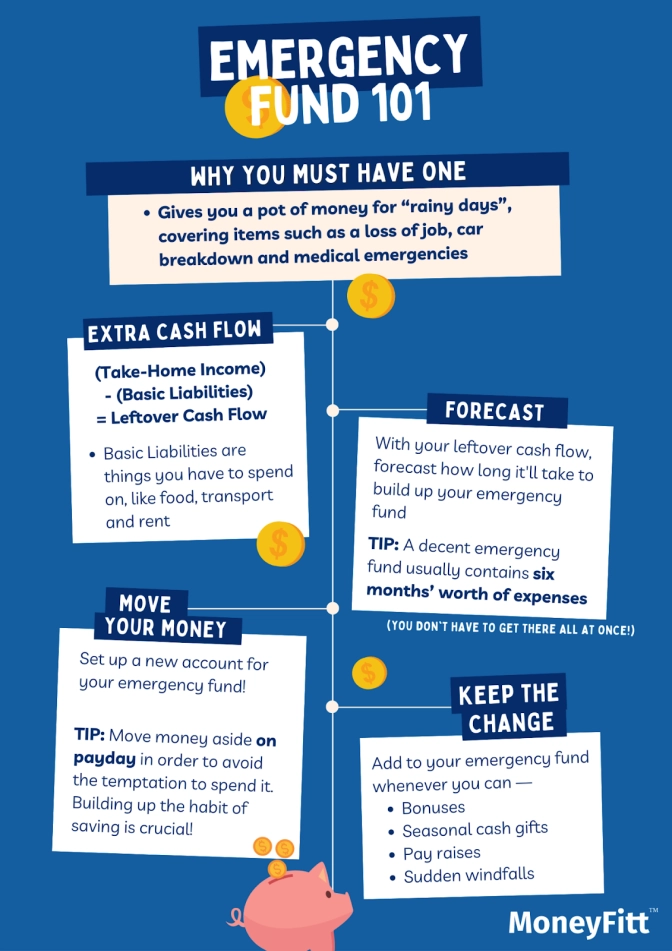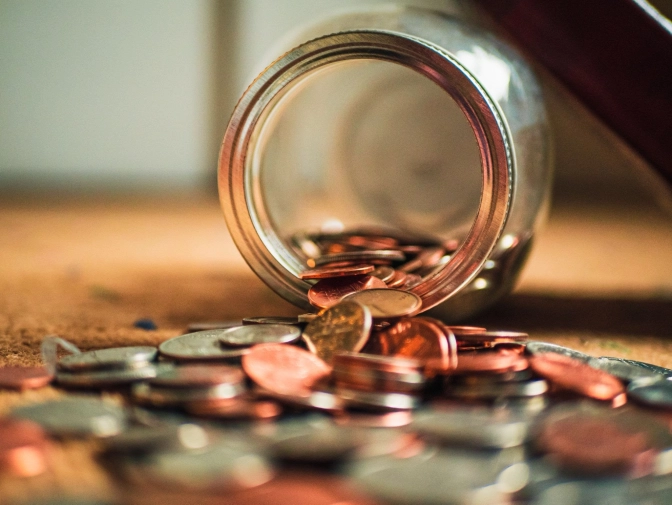Why You Must Have An Emergency Fund and How To Save For It
Turn your rainy days into minor inconveniences!
- Establishing an emergency fund gives you a pot of money for “rainy days”, covering items such as a job loss, car breakdown, home repairs or even a medical emergency.
- A decent emergency fund usually contains six months’ worth of expenses - though you don’t have to get there all at once. We typically use your after-tax take-home pay as a proxy for expenses.
- In just a few easy steps, you can easily calculate how long your emergency fund will take to complete.
What Is an Emergency Fund?
By setting up an emergency savings fund, you're prepared for the unexpected. An emergency fund covers expenses such as urgent car repairs, home repairs, pet surgeries or sudden hospitalisations. It's essentially a fund to keep you afloat on “rainy days”.
Having an emergency fund is especially essential if you're already in debt. Having an emergency fund means there's no need to rely on potentially high-interest loans or credit cards in the event of an emergency. In this guide, you’ll learn more about emergency funds and how to plan for them.

How Much Should I Save?
Simply put, this depends on the stability of your household income. The more stable your household income is, the less you need in your fund. For example, a stable two-income household is unlikely to need as high an emergency fund as a one-income family.

While small amounts, say $1,000, can cover some emergencies, they're insufficient for covering things like living expenses, rent and food for long periods. As such, a good goal is to save enough funds to cover six months' worth of expenses. (You can use your after-tax take-home pay as a quick proxy for your expenses). Of course, most people would find it extremely daunting to save up such a large amount of money all in one go, so start with small, achievable targets first, which also helps build up a habit of saving and living well within your means.
Moreover, if you’re a freelancer or work in seasonal employment, chances are that your income is less stable - so you should aim for a higher target than six months of expenses. This fund will shield you when there's less demand for your skills or if you need to search for a new job. Another risk factor to consider is the existence of chronic health conditions within your family. If this is the case, then the chance of having sudden large medical bills is much higher.
How Can I Use My Emergency Funds?
When estimating how much you need to save, these are the areas to look out for. By accounting for them in your saving goals, you’ll be well-prepared for any emergencies.
Housing: your emergency fund could include reserves for rent/mortgage, property insurance, utilities and tax. In an emergency, the priority is to safeguard your property.
Debt repayment: to maintain your credit score, your emergency fund should cover debt repayments for at least six months. Examples of such debts include credit cards, housing, or student loans. Having an emergency fund of this size prevents the interest on your loans from piling up, too.
Food: calculate how much you'll have to spend on groceries per month, assuming you dine at home every day. Remember that in an emergency, you should keep dining at home as much as possible to reduce expenses. That means no more bubble tea!
Insurance: include monthly premiums paid on different insurance categories, such as medical, dental, disability and life insurance policies.

Transportation: your fund should also cover travel expenditures. Include public transport fares, as well as allowances for ride-hailing if you must. If you have a car and use it often, include car loan repayments, road tax, insurance, fuel and maintenance/repairs.
Personal expenses: this is a broad category that includes varying expenditures on examples such as hobbies, entertainment, haircuts, toiletries and gifts. These small costs can add up quickly, so have them in your estimates!
Where Should I Keep My Emergency Fund?
Ideally, store emergency funds in a savings or fixed deposit account, which can earn interest. This account may come with a debit card, but try not to carry it around with you! Ultimately, your emergency fund should be in a separate savings account from your main current and savings accounts. It’s even better to put it in an account with a different bank to add a little friction (at the cost of a little extra mental clutter). This way, it’s not as easy to withdraw until you have to in a real emergency.
Building up a substantial emergency fund can take a while. We’ll go more in-depth into how to build it up in the next section.
Meanwhile, in the very short term, having an available line of credit (i.e. a credit card) below your credit limit can pay for emergencies. Don't wait until you have an emergency to deal with before you apply! Note - a credit card is not a permanent substitute for an emergency fund.
How to Build Your Emergency Fund
Just like the size of your fund, the speed at which you build your emergency fund also depends on the stability of your income and household. Obstacles like debt are important to deal with as quickly as possible and may restrict your ability to build up your fund. We’ve all learnt about needs and wants in primary school, so now, as a working adult, it's paramount that you now put that into practice. You guessed it, that Gucci belt is not essential!

Regarding budgeting, we follow the ‘pay yourself first’ version of the 50:30:20 rule. It prioritises ‘paying yourself’ by first allocating after-tax income to savings and investments (20%) before putting the rest towards essential needs (50%) and then discretionary spending (30%). Your emergency fund contributions fall under the savings and investments category. That’s right, before essential needs!
Why Do We Have This First?
First, repayment of debt (with high interest rates) is of utmost importance, so deal with this as soon as possible. By being aware of your financial goals, you can allocate your 20% accordingly. The importance of saving for long-term financial goals from an early age cannot be understated! It’s not just a chore either - there are some real benefits to it, such as early retirement. Putting 20% of what you make into your savings and investments first is the target. You don't have to start with it immediately, but try to make it 20% once you can.
After calculating how much you'll allocate towards savings and investments, you can determine how many months you want to finish building your fund.
For example, Mrs Lee’s leftover cash flow is $1,500 per month, and she wants to save $9,000, meaning that she could aim to achieve that in six months. Alternatively, she could slowly build it up over two years, saving $375 per month, though, of course, she’d be at greater risk should something terrible happen in the meantime.
After you’ve calculated the total amount you want to save per month, here are some additional steps to take:
- Move money aside on payday to avoid the temptation to spend it. Building up the habit of regularly saving is crucial!
- Depositing cash gifts and bonuses straight into your emergency fund. This may not be a regular saving opportunity, but it could amount to a substantial amount of your fund!
Following these easy steps will help you to easily accomplish your emergency fund goal. You’ll be amazed at how rapidly the fund piles up!
Imagine how big a relief it would be to know that you have a financial safety net in place. Being financially prepared for unexpected expenses results in peace of mind. Your rainy days are now nothing more than mere inconveniences.
EMERGENCY FUNDS. COMPLETED. ✅
Sources:
- https://www.khanacademy.org/college-careers-more/personal-finance/pf-saving-and-budgeting/tips-for-tracking-and-saving-money/a/how-to-establish-an-emergency-savings-fund
- https://sg.finance.yahoo.com/news/best-savings-accounts-singapore-park-035736066.html
- https://www.uob.com.sg/onecards/uob-one-account.html
- https://www.dbs.com.sg/personal/deposits/bank-earn/multiplier#:~:text=No%20initial%20deposit%20required.,SGD%20%26%20foreign%20currency%20balances).
- https://www.ocbc.com/personal-banking/deposits/360-savings-account
